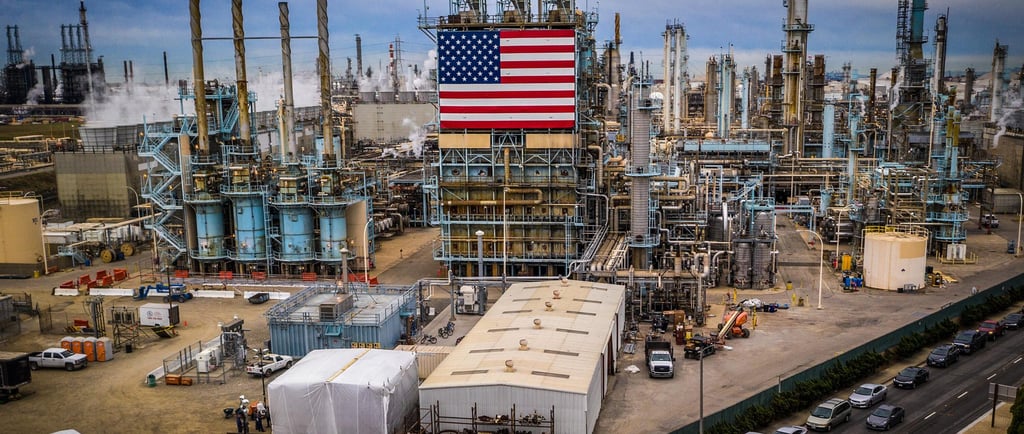United States: Reindustrialisation and its Global Implications
The United States is witnessing a significant shift towards reindustrialisation, reversing decades of deindustrialisation and reshaping its economic landscape. What does this mean for businesses, investors, and global competition?
UNITED STATES
Roman Frantsyian
10/28/20244 min read


Reindustrialisation has become a fundamental economic shift that is rapidly transforming the landscape of global competition. For decades, the world, especially countries like the United States, embarked on the path of deindustrialisation, outsourcing much of their manufacturing prowess to low-cost labour markets. As economies prioritised service industries and financial markets, traditional manufacturing hubs—cities like Detroit—became ghostly remnants of their former glory. Yet today, a new momentum is building, signalling a return to industrial roots as nations seek to reclaim their lost dominance in manufacturing and economic influence. This shift is not just about jobs but about regaining strategic sovereignty and positioning for the future.
Detroit, once the global beacon of the automotive industry, exemplifies the dramatic fall from grace seen across America’s industrial heartland. In the 1960s, the city represented the pinnacle of American industrial might, a powerhouse of innovation and economic growth. But by 2013, the story had changed dramatically. Detroit's streets, once bustling with activity, became overrun with dereliction, as unemployment soared to staggering levels, and crime rates reached unprecedented heights. The fall of Detroit mirrored the broader collapse of America’s Rust Belt, where the exodus of manufacturing left entire regions economically shattered and socially fractured.
This widespread deindustrialisation can be traced back to the forces of globalisation that took root in the late 20th century. America and other advanced economies, in a bid to reduce costs and increase profits, shifted production to countries like China, where labour was cheap, and regulations were minimal. By doing so, the U.S. inadvertently fuelled the rise of its biggest economic rival. In just two decades, China grew from a relatively minor player to the dominant force in global manufacturing, controlling nearly a third of global industrial output by 2020.
For the U.S., this outsourcing strategy came at a high price. While the service and financial sectors grew, the country's industrial backbone crumbled, leaving millions without stable, well-paying jobs. The middle class, once the bedrock of American prosperity, was hollowed out. The shift was not just about losing factories—it was about losing the identity and resilience that industry provided. As manufacturing declined, the economic and social fabric of entire communities unravelled, leading to a rise in inequality, unemployment, and poverty.
Reindustrialisation is not a nostalgic return to the past—it is a calculated response to modern challenges. At its core, this shift represents a strategic imperative to regain control over critical industries. In an increasingly technology-driven world, manufacturing goes far beyond steel and automobiles. Semiconductors, electric vehicles, renewable energy technologies, and defence-related manufacturing are now the keys to global power. Whoever controls these industries controls the future.
The geopolitical rivalry between the United States and China has only intensified the urgency for reindustrialisation. The realisation that over-reliance on China for essential components—particularly in sectors like semiconductors—poses a grave threat to national security has pushed the U.S. to act decisively. No longer can a superpower afford to be dependent on an adversary for the very technologies that underpin its economy and defence.
The passage of landmark legislation such as the Chips and Science Act in 2022 marked a pivotal moment in America's reindustrialisation journey. With $52 billion dedicated to bolstering domestic semiconductor production, the U.S. has signalled its intent to reclaim leadership in this critical sector. Companies such as Intel and TSMC are investing billions in new U.S. factories, aiming to reduce reliance on foreign production and secure supply chains for future generations.
Reindustrialisation is not just about resurrecting traditional industries; it is intrinsically tied to the future of energy and sustainability. The Biden administration’s reindustrialisation strategy is deeply intertwined with its climate agenda, positioning the U.S. as a leader in clean energy and the transition away from fossil fuels. This alignment ensures that America is not just competing with China in the technologies of the present but is leading in the industries of tomorrow.
The Inflation Reduction Act and the Infrastructure Investment and Jobs Act have channelled hundreds of billions of dollars into renewable energy projects and electric vehicle (EV) manufacturing. These investments are laying the foundation for a future where industrial growth is no longer synonymous with environmental degradation. Instead, reindustrialisation is being framed as the pathway to a sustainable, low-carbon economy.
For businesses, this presents a golden opportunity. Those who can innovate and lead in green technologies stand to benefit immensely from government subsidies, tax incentives, and a growing demand for eco-friendly products. Whether it is manufacturing solar panels, wind turbines, or batteries for electric vehicles, companies that align their strategies with the energy transition will find themselves on the cutting edge of this industrial resurgence.
Reindustrialisation is already starting to reshape the U.S. economy. Investment in manufacturing has surged, foreign direct investment (FDI) is flowing back into the country, and millions of high-paying jobs are being created. After two decades of industrial stagnation, the sharp rise in capital spending and job creation since 2022 is nothing short of transformative.
However, the path forward is not without challenges. The reindustrialisation process comes with significant costs. Building new factories, reshoring supply chains, and training workers in advanced manufacturing require massive investments, both from the public and private sectors. This has already contributed to inflationary pressures, as companies pass on the costs of higher labour and production expenses to consumers. The Federal Reserve is thus faced with the delicate task of balancing economic growth with price stability, a challenge exacerbated by the economic disruptions of the COVID-19 pandemic.
For businesses, navigating this landscape requires strategic foresight. On the one hand, companies that invest in American manufacturing stand to benefit from substantial government support, but they must also contend with a protectionist trade environment. The Biden administration’s Buy American mandates, which require that a large percentage of components for government-funded projects be domestically sourced, are reshaping supply chains. This is particularly challenging for firms that have built their models around low-cost production in Asia.
Reindustrialisation is forcing businesses to rethink their strategies for innovation. The energy transition, in particular, is creating a massive demand for new technologies and infrastructure. Companies that can lead in areas like battery production, electric vehicles, and renewable energy technologies will be well-positioned to capitalise on this shift, but those that fail to adapt may find themselves outpaced by their more forward-thinking competitors.


